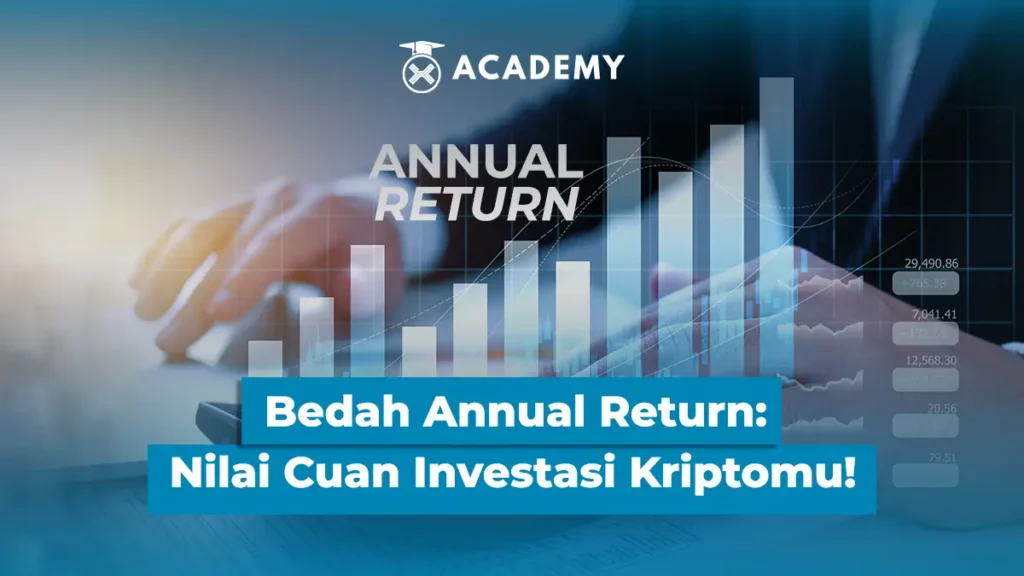Many crypto investors are often captivated by statements like “this token’s price has risen 200% in a year.” However, many misunderstand its meaning in the context of annual performance.
In the highly volatile crypto market, return figures can be deceiving, as they sometimes appear fantastic, but are actually just the result of short-term fluctuations.
This is where the concept of annual return plays a crucial role, helping you assess the performance of crypto assets more rationally and realistically.
What is Annual Return?

Essentially, the annual return is the percentage gain or loss of an investment over a full year.
This figure shows how well your investment performed over a year, not simply the total increase in value from beginning to end indefinitely.
The difference with the total return is quite clear. The total return calculates all the gains you earned over a given period, such as two years, five years, or even more.
Meanwhile, the annual return averages these results into an annualized measure so you can see what percentage your investment grew each year.
For example, you buy Bitcoin (BTC) at the beginning of the year for IDR 500,000,000, and by the end of the year, its value has increased to IDR 750,000,000.
This means your annual return was 50% for that year. This figure provides a direct indication of how well your assets performed over the course of the year.
Simply put, the annual return is like a semester-end report for your investment portfolio. From it, you can see whether your investment value has increased, decreased, or remained stable throughout the year.
Components of Annual Return
Now, before calculating, it’s important to understand where the return figure comes from. In crypto investing, annual returns are usually formed from the following components:
1. Capital Gain/Loss
This comes from the difference in the asset price between when you buy and when you sell, or from the change in its value at the end of the period. If the price rises, you make a gain. If it falls, you make a loss.
2. Yield/Dividend
In the crypto world, dividends can come from crypto staking, yield farming, or other reward programs. This type of passive income contributes to the total profits you accumulate throughout the year.
3. Holding Period
The length of time you hold an asset also matters. The longer the holding period, the more compounding effects, for example from staking rewards, can increase the value of your assets more rapidly.
How to Calculate Annual Return (Simple Steps)
To find out how much profit your investment will make in one year, you can use the following basic formula:
Annual Return = ((Ending Value – Initial Value) / Initial Value) × 100%
For example, you buy ETH at the beginning of the year for IDR 20,000,000, and then a year later its value increases to IDR 26,000,000.
The calculation is:
Annual Return = ((26 – 20) / 20) × 100% = 30%
This means your annual return for the year is 30%. However, this figure does not take into account transaction fees, staking fees, or other deductions that could affect the final result.
If you want to calculate returns for a period of less than one year, you can use the advanced version, the annualized return.
This formula adjusts short-term investment returns to reflect annual performance, for example, when comparing staking or yield farming strategies.
But don’t be too quick to get excited, because high numbers don’t necessarily mean sustainable profits.
Annual Return vs. Annualized Return vs. CAGR
Now that you know how to calculate annual investment returns, it’s important to understand that the term “annual return” isn’t just one type.
There are several versions investors often use to assess asset performance, depending on the length of the period and the calculation method, including:
1. Annual Return
Annual return shows the investment return over a full year. The formula is quite simple: the difference between the ending value and the beginning value divided by the beginning value.
For example, if you buy Solana at the beginning of the year for IDR 1,000,000 and by the end of the year, its value has increased to IDR 1,400,000. Then, the annual return = ((1.4 – 1) / 1) × 100% = 40%. This figure reflects the asset’s performance over just one year.
2. Annualized Return
If your investment is less than 12 months, you can adjust the results to reflect annual performance. For example, if you earn a 5% profit in 3 months, then if you translate it into a year, the result is approximately 20% per year (5% x 4 quarters).
This way, you can compare the performance of various assets, even if the investment duration is different.
3. CAGR (Compound Annual Growth Rate)
CAGR describes the average annual growth rate over a period of more than one year and takes into account the compounding effect. For example, if you invest IDR 10,000,000, and five years later, the value is IDR 20,000,000.
So, using the formula CAGR = ((Ending Value / Initial Value)^(1/n)) – 1, the result is ((20/10)^(1/5)) – 1 = 14.87% per year. This means that your investment has grown by an average of 14.87% annually for five consecutive years.
So, not all “annual returns” are apples to apples. Each has a different context and function depending on the duration, type of asset, and your investment goals.
Advantages & Limitations of Annual Returns
One reason why annual returns are often used is because the method is very simple. Simply look at the change in asset value from the beginning to the end of the year, then convert it to a percentage. No complicated formulas or in-depth technical data are required.
Furthermore, annual returns can also provide a quick overview of how well an asset performed over the course of a full year.
For investors who want to know “how much my investment returned this year,” this metric is a practical choice. In a sense, annual returns are like a “year-old snapshot” of an asset that’s concise, clear, and easy to understand.
However, on the other hand, annual returns have many limitations that often lead investors to misinterpret them. This figure doesn’t show how wildly price movements have fluctuated over the year, whether the asset has dropped sharply and then risen again, or whether it has remained stable over time.
For high-risk assets like crypto, this is a major problem. For example, a token might rise 100% at the end of the year, but its price fluctuates by 80% throughout the year.
If you only look at the annual return, you might think the performance is extraordinary, but in fact, the volatility is extreme and the risk is very high.
Furthermore, annual returns are also less suitable for comparisons between assets with different characteristics.
Stocks, bonds, and crypto assets, for example, have different risk patterns and cycles, making annual returns impossible to compare fairly over the long term.
Therefore, smart crypto investors don’t just focus on annual returns but also consider the underlying risk and volatility.
Why Annual Returns Matter in the Crypto World

Even though the crypto world moves quickly and prices can change drastically in a matter of minutes, annual returns remain an important metric to pay attention to.
Amidst extreme volatility, this figure helps you see the big picture: how well your assets have held up and grown over the course of a full year.
So, while the crypto market can often be dizzying due to its fluctuations, annual returns provide a stable reference point for assessing long-term performance.
Many investors use annual returns to compare the performance of different tokens. For example, you can see how the annual growth of Bitcoin and Solana compare.
From there, you can determine which asset is more consistently profitable or more vulnerable to price declines.
Furthermore, this metric is also useful for evaluating your investment strategy. Is your DCA (Dollar-Cost Averaging) method more effective than staking or HODL?
By looking at the annual returns of each strategy, you can assess which approach is most efficient for your risk profile.
For investors with a diversified portfolio, annual returns can also be used to measure the overall efficiency of your portfolio.
From there, you can determine whether your asset allocation is optimal or whether adjustments are needed to maximize results.
With annual returns, you can determine whether your investment performance is truly outperforming the market or simply following the hype without tangible results.
Conclusion – Don’t Be Afraid of Numbers, Understand Their Meaning
So, that was an interesting discussion about Analyzing Annual Returns: A Simple Way to Assess Crypto Asset Performance, which you can read in full at the INDODAX Academy.
In conclusion, annual returns are often considered simply a number that indicates how much profit was earned in a year.
However, they are much more than that. This number can be a useful measuring tool if you know how to read it correctly, not just looking at the final result but also understanding the journey behind it.
Successful investors aren’t those with the highest returns, but those who understand the meaning behind the numbers, the risks involved, the strategies used, and how consistent their performance has been over time.
So, when assessing assets or portfolios, don’t be immediately captivated by big numbers on the screen. Use long-term logic: look at trends, understand the context, and realize that in the crypto world, understanding is more important than hype.
By the way, in addition to gaining in-depth insights through various popular crypto education articles, you can also broaden your horizons through a collection of tutorials and choose from a variety of popular articles that suit your interests.
Besides updating your knowledge, you can also directly monitor digital asset prices on Indodax Market and stay up-to-date with the latest crypto news. For a more personalized trading experience, explore Indodax’s OTC trading service. Don’t forget to activate notifications so you don’t miss out on important information about blockchain, crypto assets, and other trading opportunities.
You can also follow our latest news via Google News for faster and more reliable access to information. For an easy and secure trading experience, download the best crypto app from INDODAX on the App Store or Google Play Store.
Maximize your crypto assets with the INDODAX Earn feature, a practical way to earn passive income from your stored assets. Register now with INDODAX and easily complete KYC to start trading crypto more safely, conveniently, and reliably!
Indodax Official Contact
Customer Service Number: (021) 5065 8888 | Support Email: [email protected]
Also follow us on social media here: Instagram, X, Youtube & Telegram
FAQ
1.What’s the difference between annual return and annualized return?
Annual return is for a full year, while annualized return adjusts for periods less than 12 months to achieve an annualized return.
2.Can annual returns in crypto be negative?
Absolutely. If the asset price drops compared to the beginning of the year, the annual return becomes negative, meaning a loss.
3.Are staking rewards included in the annual return?
Yes, if the rewards are received regularly and can be converted to an annual value, they can be considered part of the total return.
4.How do I find the annual return on a crypto asset?
You can view it on analytics sites like CoinMarketCap or calculate it manually from the beginning and end of the year.
5.Why is annual return important for crypto investors?
Because it helps you assess asset performance more objectively, rather than simply following daily price hype.
Author: Boy






 Polkadot 9.23%
Polkadot 9.23%
 BNB 0.57%
BNB 0.57%
 Solana 4.89%
Solana 4.89%
 Ethereum 2.37%
Ethereum 2.37%
 Cardano 1.22%
Cardano 1.22%
 Polygon Ecosystem Token 2.17%
Polygon Ecosystem Token 2.17%
 Tron 2.83%
Tron 2.83%
 Market
Market


